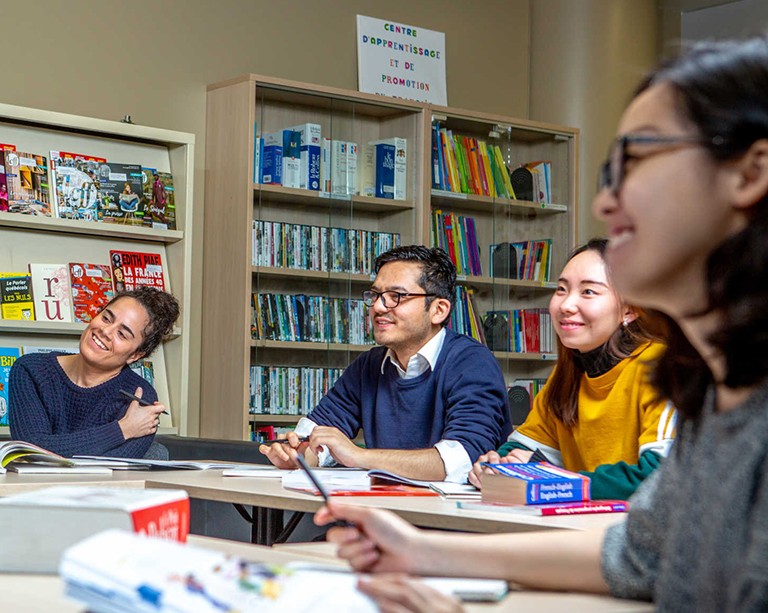New Concordia Graduate Microprogram and Graduate Certificate in Curatorial Studies and Practices will offer unique, hands-on experience in a state-of-the art lab
 Rebecca Duclos: “We try to undefine what curating can be so that it becomes a very open practice.”
Rebecca Duclos: “We try to undefine what curating can be so that it becomes a very open practice.”
Concordia’s new Graduate Microprogram and Graduate Certificate in Curatorial Studies and Practices provide students with a portable set of skills, experiences and a network of people that will complement any number of future endeavours in or outside the art world.
These latest Department of Art History offerings also reflect Concordia’s ongoing efforts toward more inclusive practices and programs. Connecting students with extraordinary curatorial professionals, the program acknowledges that there are many different types of expertise in the world of visual culture.
The Elspeth McConnell Critical Curatorial Laboratory is the heart of these new activities. Made possible by a generous donation from the Doggone Foundation — and named in honour of the foundation’s benefactor — this space will enable students to stage anything they can imagine.
“There's nothing quite like it in Montreal and there's not likely to be anything quite like it in Canada,” says Rebecca Duclos, graduate program director and professor of art history.
Activating research
“In the last 25 years especially, the field of curating has changed dramatically,” Duclos notes.
“What used to be considered the primary domain of museums and galleries now includes community events, festivals, cinema techs, pop-up experiences and collaborative ‘happenings’ — it's so broad and it's a very interesting form of practice that can be anything from pure aesthetics to radically activist.”
Duclos adds that it’s essential for students to leave university with a network and a whole bag of tricks.
“Students who complete the full program will curate some kind of project by the end of it, learning hands-on what they need to build a project of their own, availing themselves of one of our many galleries or by transforming the lab into a temporary project space. Students may decide to curate the work of other artists in the Visual Arts (VA) Building — which is such great exposure for those other students, too.
“There is an increased sense that curating is a form of active research — of activated research. It often involves communities now — and visitors, audiences.”
 Dean Annie Gérin with Alice Ming Wai Jim, Joana Joachim and Michelle McGeough at the Doggone Foundation event.
Dean Annie Gérin with Alice Ming Wai Jim, Joana Joachim and Michelle McGeough at the Doggone Foundation event.
Radical inclusivity
Duclos developed the new curatorial offerings in collaboration with fine arts faculty Alice Ming Wai Jim, Michelle McGeough and Joanna Joachim.
“We really loved working together on this project,” Duclos says. “The Department of Art History has a number of practitioners who are classic art historians but many of them have a curatorial practice in addition to, or parallel, to their work. There's expertise in the department but there is also a strong connection to the rest of Montreal — not only with our sister institutions in the educational sector but in the cultural sector as well.”
Duclos points out that the program will also allow Concordia to bring in people from the community who are professionals who would not normally teach in its departments.
“Students will be exposed to extraordinary cultural professionals, and these curators will, in turn, get to be in the university and meet our students.”
As Duclos points out, this approach acknowledges that expertise in visual culture is not necessarily connected to a vast body of publications. “It's not always about scholarly papers and articles and books,” she says. “It can be about entire enormous exhibition projects or biennales. It’s about a kind of diversity — of interests and expertise — being recognized.
“The courses are intentionally progressive and inclusive — I would say close to radical. We try to undefine what curating can be so that it becomes a very open practice. It may be institutional, but it may be entirely ephemeral.”
Vast, transferable skills
The Elspeth McConnell Critical Curatorial Laboratory will be unlike any other space — an actual working classroom space devoted to hands-on curating practices.
“Most curatorial programs have a gallery where students can practice handling, matting, hanging, lighting, sound and projections,” Duclos says. “We're going to have the ability to turn the whole room into a laboratory where students can practice these skills toward a project of their own making — everything that you would have to know to build a show.”
Concordia’s Faculty of Fine Arts is one of the largest in North America, with studio arts programs, design and performance —"we have the unbelievable internal ability to ‘practice’ curating through potential collaborations with our own people on site.
“The skills that one gains as a curator are phenomenally useful out in the world,” Duclos emphasizes. “Everything from project management to community liaison, to literally hanging a show, writing the texts, producing publications and developing educational or public programs. If you're a one-person curator, you kind of have to do everything.”
Join an exciting hybrid info session about Concordia’s new Graduate Certificate and Microprogram in Curatorial Studies and Practices on Thursday, January 16 from 3 to 5 p.m. Attend in-person at Concordia’s Engineering and Visual Arts (EV) Building in Room 3.711 or online by RSVP.


